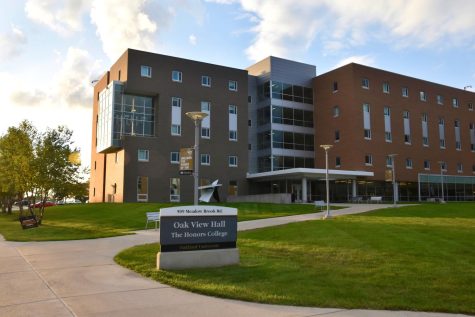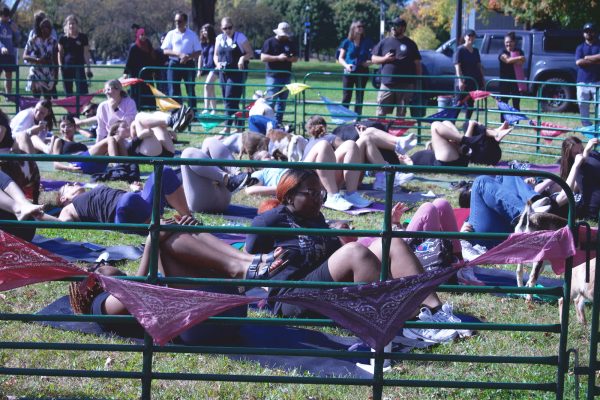Tuition increases 8.48 percent for fall semester
An across-the-board tuition increase was approved on Tuesday, July 7, for the 2016 academic year. The proposal, issued by Oakland University President George Hynd, provided an increase in tuition for 8.48 percent. The Board of Trustees unanimously approved the proposal after a brief discussion following Hynd’s presentation. This increase will add $30 per credit hour to resident undergraduates starting in the fall 2015 semester and lasting until a new proposal presented next summer.
Separating tuition by school
The accepted proposal increased tuition for all undergraduates at the same rate, with the exception of four schools. The School of Health Sciences will see a $10 to $20 differential increase per credit hour. This will rank OU as the sixth cheapest School of Health Sciences program for lower level classes in Michigan out of 12 universities.
The School of Business Administration will see a $20 to $30 differential increase per credit hour. They will then rank as the fifth cheapest program for lower level classes out of 15.
The School of Nursing will experience a $25 to $35 differential increase per credit hour. This will rank them as the fifth cheapest program out of 12.
The School of Engineering and Computer Science will see a $30 to $40 differential increase per credit hour. This will rank them as the sixth cheapest program out of 13. These four schools will experience increased tuition raises because of their extra need for equiptment and classroom experience. The School of Engineering and Computer Science, the School of Nursing and the School of Health Sciences require expensive lab equiptment and materials. The higher individual tuition costs will help to offset this rising cost, according to Hynd.
The School of Business Administration must hire professors in a market where business professors are in a need. Because of this, faculty salaries in the School of Business Adminisration must be increased. When it comes to the ranking of the universities by department, OU currently ranks in the lower third for all four schools. With this increase in tuition, each department will move the middle of the pack, which Hynd explained as a desirable place to be. “We’re doing all of this to improve the quality of this institution,” Hynd said.
The risk of violating state cap
By increasing tuition to 8.48 percent, OU violated the state cap rule of 3.2 percent. This cap means that the state will provide the university with $1.2 million if their tuition increase is at or under 3.2 percent.
By violating this cap and increasing by over five percent greater, OU will not receive the state aid. In return, though, the university is looking at $12 million from the increased tuition prices. With universities submitting tuition changes across Michigan, Eastern Michigan University proves most comparible to Oakland’s hefty increase. Eastern Michigan University increased its tuition by 7.8 percent in June, just under OU’s increase percentage.
Wayne State University and Western Michigan University announced tuition raises of 3.2 percent, which are equivilant to the state cap. These universities will profit little in tuition from students, but will receive the state aid.
Over the last three years, OU has not increased tuition more than four percent. Raising it nearly another five percent this year, the university hopes to make up for lack of state funding. “In 1972, we were getting 82 percent from the state for funding,” said John Beaghan, Oakland CFO. “It has more than flipped since then and we need to account for that.” OU is the least-state funded university per student, falling just behind Grand Valley State University.
Spending the increases
In the Board of Trustees meeting, Hynd laid out a plan for spending the money come fall. The university looks to follow a strategic plan of three steps.
The first strategic goal is to foster students through a robust teaching and learning environment, said Hynd in the meeting. To accomplish this with the new budget, faculty counts will be increased to decrease the student-teacher ratio.
Also, there will be changes made to the handicap accommodations and an increase in psychologists and advisors.
The second strategic goal focuses on the coverage of the university as a research and scholarly environment. To further this experience for students, library collections, teaching spaces and specialized labs will be increased. There will also be the addition of new research support and equipment. Hynd’s third strategic goal is for the university to become a leader in serving the needs and aspirations of surrounding communities, he said during the meeting.
To increase community engagement, money will be spent on enhanced career services and internships, which includes a partnership with the city of Pontiac. Topping the list of improvements and expansions, the Oakland Center will seek additional renovations after the tuition increase.
Though changes won’t be seen right away, the impact on students of a new Oakland Center can be worth it, according to student liason Annie Meinberg. “This tuition increase is a hard hit at first,” Meinberg said. “But the expansion and renovations in the Oakland Center has been a need that’s been here for years.”
The new tuition prices will be in effect for the fall 2015 semester. With a $30 per credit hour increase for undergraduates, increased financial aid opporunities will be presented.













